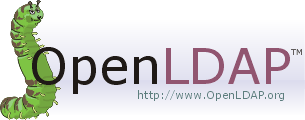Manuel Parra ([email protected]) & José Manuel Benítez ([email protected]), December 2016
This course must be done on docker.ugr.es
Default password for LDAP admin user is password
The openldap-clients package installs tools which are used to add, modify, and delete entries in an LDAP directory. These tools include the following:
-
ldapadd — Adds entries to an LDAP directory by accepting input via a file or standard input; ldapadd is actually a hard link to ldapmodify -a.
-
ldapdelete — Deletes entries from an LDAP directory by accepting user input at a shell prompt or via a file.
-
ldapmodify — Modifies entries in an LDAP directory, accepting input via a file or standard input.
-
ldappasswd — Sets the password for an LDAP user.
-
ldapsearch — Searches for entries in an LDAP directory using a shell prompt.
-
ldapcompare — Opens a connection to an LDAP server, binds, and performs a comparison using specified parameters.
-
ldapwhoami — Opens a connection to an LDAP server, binds, and performs a whoami operation.
-
ldapmodrdn — Opens a connection to an LDAP server, binds, and modifies the RDNs of entries.
LDAP is a lightweight protocol for accessing directory servers. Okay, so what is a directory server? It’s a hierarchical object orientated database.
Data in LDAP are stored in objects. These objects contain a number of attributes, which are basically a set of key/value pairs. Because data in LDAP is structured, objects can only contain valid keys, and which keys are valid is dependant on what class the object is. Classes in LDAP can define mandatory attributes and optional attributes and their type.
Classes are assigned to objects using the objectClass attribute. LDAP defines some basic classes, types and comparison methods by default, but you are free to define your own.
The data itself in an LDAP system is mainly stored in elements called attributes. Attributes are basically key-value pairs. Unlike in some other systems, the keys have predefined names which are dictated by the objectClasses selected for entry. Furthermore, the data in an attribute must match the type defined in the attribute's initial definition.
...
home: /home/mparra
...
Attributes by themselves are not very useful. To have meaning, they must be associated with something. Within LDAP, you use attributes within an entry.
An entry is basically a collection of attributes under a name used to describe something.
# LDAP user entry example
dn: cn=mparra,ou=Users,dc=openstack,dc=org
objectClass: top
objectClass: account
objectClass: posixAccount
objectClass: shadowAccount
cn: mparra
...
A DIT is simply the hierarchy describing the relationship of existing entries.
Upon creation, each new entry must "hook into" the existing DIT by placing itself as a child of an existing entry.
This creates a tree-like structure that is used to define relationships and assign meaning.
It functions like a full path back to the root of the Data Information Trees, or DITs.
For example:
dn: cn=mparra,ou=Users,dc=openstack,dc=org
cn: Common name
ou: organizational segment / Organizational Unit
dc = Domain Component
The direct parent is an entry called ou=Users which is being used as a container for entries describing users.
The parents of this entry derived from the openstack.org domain name, which functions as the root of our DIT.
These are often used for the general categories under the top-level DIT entry, things like ou=people, ou=groups, and ou=inventory are common.
First, with your user account (logged) try out:
ldapsearch -H ldap://localhost -LL -b ou=Users,dc=openstack,dc=org -x
This command returns the list of LDAP users (something similar):
...
dn: ou=Users,dc=openstack,dc=org
objectClass: organizationalUnit
ou: Users
dn: cn=Robert Smith,ou=Users,dc=openstack,dc=org
objectClass: inetOrgPerson
cn: Robert Smith
cn: Robert J Smith
cn: bob smith
sn: smith
uid: rjsmith
carLicense: HISCAR 123
homePhone: 555-111-2222
mail: [email protected]
mail: [email protected]
mail: [email protected]
description: swell guy
ou: Human Resources
...
The format for a simple query with ldapsearch is:
ldapsearch -H <host> -LL -b ou=<Organizational Unit> -x
LDAP utility ldaputility cointains multiple options and configuration, please review: https://www.centos.org/docs/5/html/CDS/ag/8.0/Finding_Directory_Entries-Using_ldapsearch.html
To add something to the LDAP directory, you need to first create a LDIF file.
The ldif file should contain definitions for all attributes that are required for the entries that you want to create.
With this ldif file, you can use ldapadd command to import the entries into the directory as explained in this tutorial.
Create a file, i.e. user.ldif and copy this skeleton, modify and include your data (i.e. cn=mparra to cn=<user>, i.e. uid=mparra to uid=<uid> , gecos etc.)
dn: cn=mparra,ou=Users,dc=openstack,dc=org
objectClass: top
objectClass: account
objectClass: posixAccount
objectClass: shadowAccount
cn: mparra
uid: mparra
uidNumber: 16859
gidNumber: 100
homeDirectory: /home/mparra
loginShell: /bin/bash
gecos: mparra
userPassword: {crypt}x
shadowLastChange: 0
shadowMax: 0
shadowWarning: 0
To add this user to LDAP directory (at openstack/org == openstack.org):
ldapadd -x -D "cn=admin,dc=openstack,dc=org" -w password -c -f user1.ldif
Syntax:
ldapadd [options] [-f LDIF-filename]
If you remove -w password option, and change by -W it will ask you about LDAP admin password.
ldappasswd -s <new_user_password> -W -D "cn=admin,dc=openstack,dc=org" -x "cn=mparra,ou=Users,dc=openstack,dc=org"
In this case, using -W option, ldappasswd ask for LDAP admin password.
Syntax:
ldappasswd [ options ] [ user ]
Please check: https://www.centos.org/docs/5/html/CDS/cli/8.0/Configuration_Command_File_Reference-Command_Line_Utilities-ldappasswd.html for more information about this command.
Now, try out:
ldapsearch -H ldap://localhost -LL -b ou=Users,dc=openstack,dc=org -x
It returns LDAP directory with the last user added.
The syntax of the ldapmodify tool on the command-line can take any of these forms:
ldapmodify [ options ]
ldapmodify [ options ] < LDIFfile
ldapmodify [ options ] -f LDIFfile
LDIF text file containing new entries or updates to existing entries on LDAP directory.
When modifying the contents of a directory, you must satisfy several prerequisite conditions.
First, the bind DN and password used for authentication must have the appropriate permissions for the operations being performed.
Create an example LDIF Modify and save the file as i.e. mparra_modify.ldif
dn: cn=mparra,ou=Users,dc=openstack,dc=org
changetype: modify
replace: loginShell
loginShell: /bin/csh
Then execute:
ldapmodify -x -D "cn=admin,dc=openstack,dc=org" -w password -H ldap:// -f mparra_modify.ldif
It will update cn=mparra with a new loginShell, in this case /bin/csh
Check if the change has been done:
...
dn: cn=mparra,ou=Users,dc=openstack,dc=org
objectClass: top
objectClass: account
objectClass: posixAccount
objectClass: shadowAccount
cn: mparra
uid: mparra
uidNumber: 16859
gidNumber: 100
homeDirectory: /home/mparra
gecos: mparra
shadowMax: 0
shadowWarning: 0
loginShell: /bin/csh
...
Adding a entry of LDAP user. Create a new file manu_add_descrip.ldif and add:
dn: cn=mparra,ou=Users,dc=openstack,dc=org
changetype: modify
add: description
description: Manuel Parra
Execute next command:
ldapmodify -x -D "cn=admin,dc=openstack,dc=org" -w password -H ldap:// -f manu_add_descrip.ldif
Now, check changes:
ldapsearch -H ldap://localhost -LL -b ou=Users,dc=openstack,dc=org -x
And finally delete description. Create a new file i.e. manu_del_descr.ldif
dn: cn=mparra,ou=Users,dc=openstack,dc=org
changetype: modify
delete: description
Then execute:
ldapmodify -x -D "cn=admin,dc=openstack,dc=org" -w password -H ldap:// -f manu_del_descr.ldif
Now, check out:
ldapsearch -H ldap://localhost -LL -b ou=Users,dc=openstack,dc=org -x
Verify if entity description is not set.
Create a new ldif file. i.e. add_new_ou.ldif with:
dn: ou=People,dc=openstack,dc=org
ou: People
objectClass: top
objectClass: organizationalUnit
description: Parent object of all PEOPLE accounts
Then use:
ldapadd -x -D cn=admin,dc=openstack,dc=org -w password -c -f add_new_ou.ldif
For instance, if we use ou=People
ldapsearch -H ldap://localhost -LL -b ou=People,dc=openstack,dc=org -x
It shows everything under ou=People from dc=openstack,dc=org
Any combination of ou, dc, ... is allowed to search into DIT.


